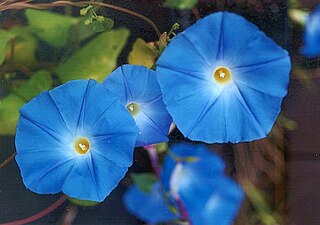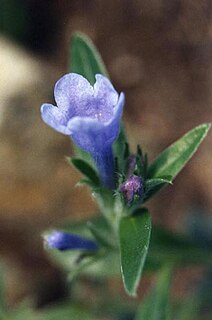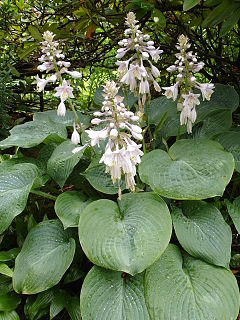
The Royal Horticultural Society (RHS), founded in 1804 as the Horticultural Society of London, is the UK's leading gardening charity.

Gentiana is a genus of flowering plants belonging to the gentian family (Gentianaceae), the tribe Gentianeae, and the monophyletic subtribe Gentianinae. With about 400 species it is considered a large genus. They are notable for their mostly large, trumpet-shaped flowers, which are often of an intense blue.

Iris is a genus of 260–300 species of flowering plants with showy flowers. It takes its name from the Greek word for a rainbow, which is also the name for the Greek goddess of the rainbow, Iris. Some authors state that the name refers to the wide variety of flower colors found among the many species. As well as being the scientific name, iris is also widely used as a common name for all Iris species, as well as some belonging to other closely related genera. A common name for some species is 'flags', while the plants of the subgenus Scorpiris are widely known as 'junos', particularly in horticulture. It is a popular garden flower.

Ipomoea tricolor, the Mexican morning glory or just morning glory, is a species of flowering plant in the family Convolvulaceae, native to the New World tropics, and widely cultivated and naturalised elsewhere. It is an herbaceous annual or perennial twining liana growing to 2–4 m (7–13 ft) tall. The leaves are spirally arranged, 3–7 cm (1–3 in) long with a 1.5–6 cm long petiole. The flowers are trumpet-shaped, 4–9 cm (2–4 in) in diameter, most commonly blue with a white to golden yellow centre.

Lathyrus latifolius, the perennial peavine, perennial pea, broad-leaved everlasting-pea, or just everlasting pea, is a robust, sprawling herbaceous perennial flowering plant in the pea family Fabaceae. It is native to Europe but is present on other continents, such as North America and Australia, where it is most often seen along roadsides.

Abies procera, the noble fir, also called red fir and Christmas tree, is a species of fir native to the Cascade Range and Pacific Coast Ranges of the northwestern Pacific Coast of the United States. It occurs at altitudes of 300–1,500 meters (980–4,920 ft).

Lavandula angustifolia, formerly L. officinalis, is a flowering plant in the family Lamiaceae, native to the Mediterranean. Its common names include lavender, true lavender or English lavender ; also garden lavender, common lavender, and narrow-leaved lavender.

Juniperus squamata, the flaky juniper, or Himalayan juniper is a species of coniferous shrub in the cypress family Cupressaceae, native to the Himalayas and China.

Geranium sylvaticum, the wood cranesbill or woodland geranium, is a species of hardy flowering plant in the family Geraniaceae, native to Europe and northern Turkey.

Glandora diffusa, the purple gromwell, syn. Lithodora diffusa, Lithospermum diffusa, is a species of flowering plant in the family Boraginaceae. It is a mat-forming perennial growing to 15 cm (6 in) tall by 60 cm (24 in) or more wide, with dark green, hairy evergreen leaves and masses of blue or white 5-lobed flowers. It is suitable for cultivation in a rock garden or alpine garden.

The Garden is the monthly magazine of the British Royal Horticultural Society (RHS), circulated to all the society's members as a benefit of membership; it is also sold to the public.

Symphyotrichum ericoides, known as white heath aster, frost aster, or heath aster, is a species of flowering plant in the family Asteraceae native to much of central and eastern North America. It has been introduced to parts of Europe and western Asia.

Caryopteris is a genus of flowering plants in the family Lamiaceae. They are native to east Asia.

Ipheion uniflorum is a species of flowering plant, related to the onions, so is placed in the allium subfamily (Allioideae) of the Amaryllidaceae. It is known by the common name springstar, or spring starflower. Along with all the species of the genus Ipheion, some sources place it in the genus Tristagma, but research published in 2010 suggested that this is not correct. It is native to Argentina and Uruguay, but is widely cultivated as an ornamental and reportedly naturalized in Great Britain, France, Australia, New Zealand and the United States.

Veronica prostrata, the prostrate speedwell or rock speedwell, is a species of flowering plant in the family Plantaginaceae, native to Europe. Growing to 10–15 cm (4–6 in) tall, it is a temperate semi-evergreen prostrate perennial plant. As it forms a mat of foliage, it is suitable for groundcover or in the alpine garden. Blue flowers are borne in summer, in terminal racemes above paired leaves.

Glandora oleifolia, the olive-leaved gromwell, is a species of flowering plant in the family Boraginaceae. The plant is native to a small rocky area near Figueras in the eastern Pyrenees, and is endemic to Spain.

Hosta sieboldiana, Siebold's plantain lily, is a species of hosta native to Japan. A putative variety, Hosta sieboldiana var. elegans, has gained the Royal Horticultural Society's Award of Garden Merit, as has a putative variety of its synonym; Hosta fortunei var. aureomarginata, the gold-edged plantain lily. The cultivars 'Blue Angel', 'Blue Mammoth', and 'Olive Bailey Langdon' have also gained the RHS Award of Garden Merit.

Glandora is a genus of flowering plants in the family Boraginaceae, native to the western and central Mediterranean region; Morocco, Algeria, Portugal, Spain, France, Italy and Greece. It was split from Lithodora in 2008.

Atriplex prostrata, called the spear-leaved orache, hastate orache, thin-leaf orache, triangle orache, and fat hen, is a widespread species of flowering plant in the saltbush genus Atriplex, native to Europe, Macaronesia, northern Africa, Ethiopia, the Middle East, western Siberia, and Central Asia, and introduced to temperate North America, South America, Australia, New Zealand, Korea, Japan, and Primorsky Krai in far eastern Russia. It is a facultative halophyte.



















